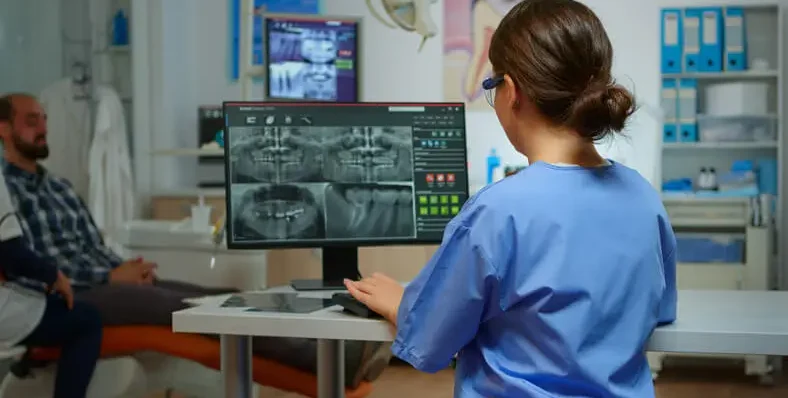In today’s fast-paced digital era, technological advancements have permeated every facet of our lives, including healthcare. Among the various fields benefiting from this digital revolution, dentistry stands out with the advent of teledentistry. Teledentistry, a subset of telehealth, encompasses the use of telecommunications and information technology to deliver dental care, consultation, education, and public awareness remotely. This innovative approach has the potential to revolutionize oral healthcare delivery by overcoming barriers of accessibility, affordability, and convenience. In this article, we delve into the concept of teledentistry, its evolution, applications, benefits, challenges, and the future it holds for oral healthcare.
Evolution of Teledentistry
The concept of telemedicine, including teledentistry, traces back to the mid-20th century when healthcare providers began experimenting with telecommunication technologies to extend medical services to remote areas. However, it wasn’t until the late 1990s and early 2000s that teledentistry gained traction as advancements in digital imaging, telecommunications, and internet connectivity facilitated its widespread adoption.
Applications of Teledentistry
Teledentistry encompasses various applications catering to different aspects of oral healthcare delivery, including:
- Remote Consultations
- Oral Health Education
- Telediagnosis and Monitoring
- Teledental Hygiene
- Specialty Care Collaboration
Remote Consultations
Teledentistry enables dental professionals to remotely diagnose and consult patients using live video conferencing or store-and-forward technology. Patients can seek expert advice and treatment recommendations without the need for physical visits, especially beneficial for those residing in rural or underserved areas.
Oral Health Education
Through online platforms and interactive tools, teledentistry facilitates the dissemination of oral health information, preventive care practices, and treatment options to patients, caregivers, and the general public. Educational resources can be accessed anytime, anywhere, promoting oral health awareness and literacy.
Telediagnosis and Monitoring
Digital imaging technologies, such as intraoral cameras and smartphone applications, allow patients to capture images of their oral cavity and transmit them securely to dental professionals for remote diagnosis and monitoring of oral conditions. This real-time monitoring aids in early detection and timely intervention, improving patient outcomes.
Teledental Hygiene
Teledentistry extends beyond clinical services to encompass preventive care, including teledental hygiene services. Dental hygienists can remotely assess patients’ oral health status, provide oral hygiene instructions, and offer personalized preventive care plans through virtual consultations.
Specialty Care Collaboration
Teledentistry facilitates multidisciplinary collaboration among dental specialists, primary care providers, and other healthcare professionals for comprehensive patient care. Specialists can remotely review cases, provide consultations, and collaborate on treatment plans, enhancing access to specialized care.
Benefits of Teledentistry
Teledentistry offers a myriad of benefits for patients, dental professionals, and healthcare systems, including:
- Improved Access to Care
- Enhanced Convenience
- Cost Savings
- Timely Intervention
- Patient-Centered Care
Improved Access to Care
Teledentistry eliminates geographical barriers, allowing patients in remote or underserved areas to access dental services remotely. This is particularly advantageous for individuals with limited mobility, transportation challenges, or residing in dental health professional shortage areas.
Enhanced Convenience
With teledentistry, patients can receive dental consultations and follow-ups from the comfort of their homes, eliminating the need for time-consuming travel and waiting room visits. This convenience promotes patient engagement and compliance with recommended treatments.
Cost Savings
By reducing the need for in-person visits and travel expenses, teledentistry can result in cost savings for both patients and healthcare systems. Patients can avoid unnecessary expenditures on transportation and accommodation, while healthcare providers can optimize resource utilization and operational costs.
Timely Intervention
Teledentistry facilitates early diagnosis and intervention by enabling remote monitoring of oral conditions and timely consultation with dental professionals. This proactive approach helps prevent disease progression, reduce complications, and improve treatment outcomes.
Patient-Centered Care
Teledentistry promotes patient-centered care by empowering individuals to actively participate in their oral health management. Patients have greater access to information, education, and personalized care plans, fostering a collaborative relationship with their dental providers.
Challenges and Considerations
Despite its numerous benefits, teledentistry also presents certain challenges and considerations that need to be addressed for its successful implementation and widespread adoption:
- Regulatory and Legal Considerations
- Technological Infrastructure
- Digital Divide
- Quality of Care
Regulatory and Legal Considerations
Regulatory frameworks governing telehealth vary across regions, posing challenges related to licensure, reimbursement, liability, and patient privacy. Standardized guidelines and policies are needed to ensure compliance with legal and ethical standards in teledentistry practice.
Technological Infrastructure
Access to reliable internet connectivity and digital technologies is essential for effective teledentistry delivery. Disparities in technological infrastructure, particularly in rural and underserved areas, may hinder access to remote dental services for certain populations.
Digital Divide
Socioeconomic factors, including income level, education, and digital literacy, influence individuals’ ability to access and utilize teledentistry services. Efforts to bridge the digital divide through education, outreach programs, and subsidized access to technology are necessary to ensure equitable access to care.
Quality of Care
Ensuring the quality and safety of teledentistry services is paramount. Dental professionals must adhere to established clinical guidelines, maintain high standards of care, and utilize secure communication platforms to safeguard patient confidentiality and privacy.
Future Directions
The future of teledentistry holds immense potential for transforming oral healthcare delivery and addressing the evolving needs of patients and dental providers. Key areas for future development and expansion include:
- Integration with Electronic Health Records (EHR)
- Telemonitoring and IoT Devices
- Artificial Intelligence (AI) in Teledentistry
- Teledentistry Research and Education
Integration with Electronic Health Records (EHR)
Seamless integration of teledentistry platforms with EHR systems can enhance care coordination, documentation, and communication among healthcare providers, improving the continuity of care for patients.
Telemonitoring and IoT Devices
Advancements in wearable devices and Internet of Things (IoT) technology enable remote monitoring of patients’ oral health parameters, such as oral hygiene practices, dietary habits, and compliance with treatment regimens. These data-driven insights can inform personalized interventions and promote preventive care.
Artificial Intelligence (AI) in Teledentistry
AI-powered tools, including image analysis algorithms and virtual assistants, can assist dental professionals in diagnosing oral conditions, treatment planning, and patient communication. Integration of AI technologies enhances diagnostic accuracy, efficiency, and decision-making in teledentistry practice.
Teledentistry Research and Education
Continued research and education are essential for advancing the evidence base, best practices, and training programs in teledentistry. Collaborative efforts among academia, industry, and healthcare organizations can drive innovation and promote the integration of teledentistry into dental curricula and continuing education programs.
Conclusion
Teledentistry represents a paradigm shift in oral healthcare delivery, leveraging digital technologies to overcome barriers of accessibility, affordability, and convenience. By enabling remote consultations, telediagnosis, education, and collaboration, it enhances patient access to quality dental care while optimizing resource utilization and promoting preventive interventions. Despite challenges related to regulation, technology, and equity, the future of teledentistry holds promise for advancing patient-centered, evidence-based oral healthcare delivery. Embracing teledentistry as an integral component of modern dental practice can pave the way for a more accessible, efficient, and equitable oral healthcare system.
Through the convergence of technology, innovation, and collaboration, teledentistry has the potential to revolutionize the way oral healthcare is delivered, empowering individuals to achieve optimal oral health outcomes regardless of geographical or socioeconomic constraints. As we navigate the evolving landscape of digital health, embracing teledentistry as a complementary modality alongside





